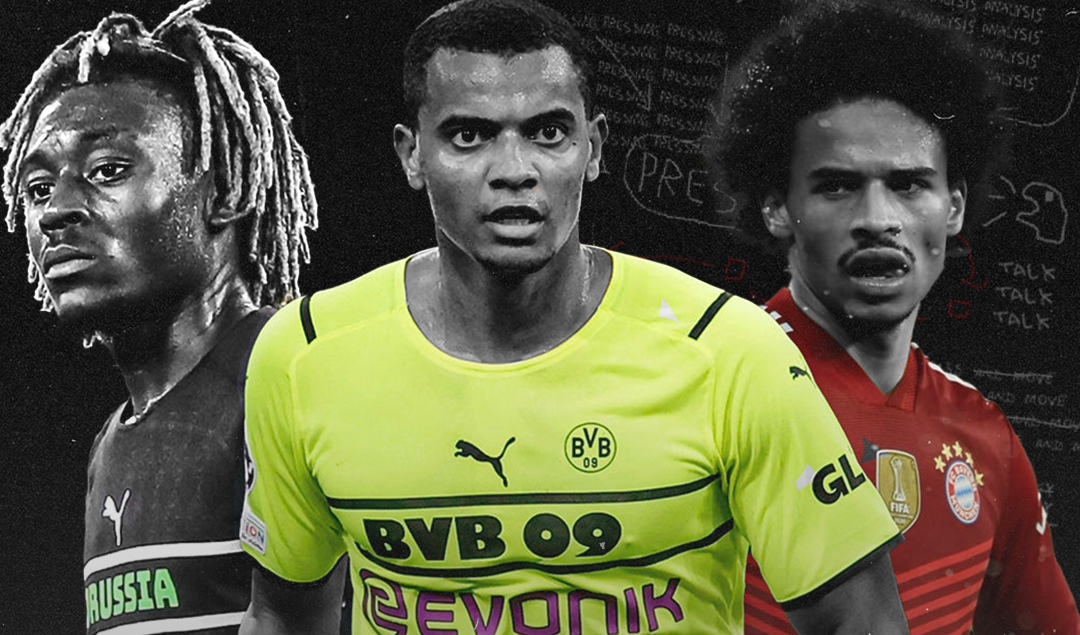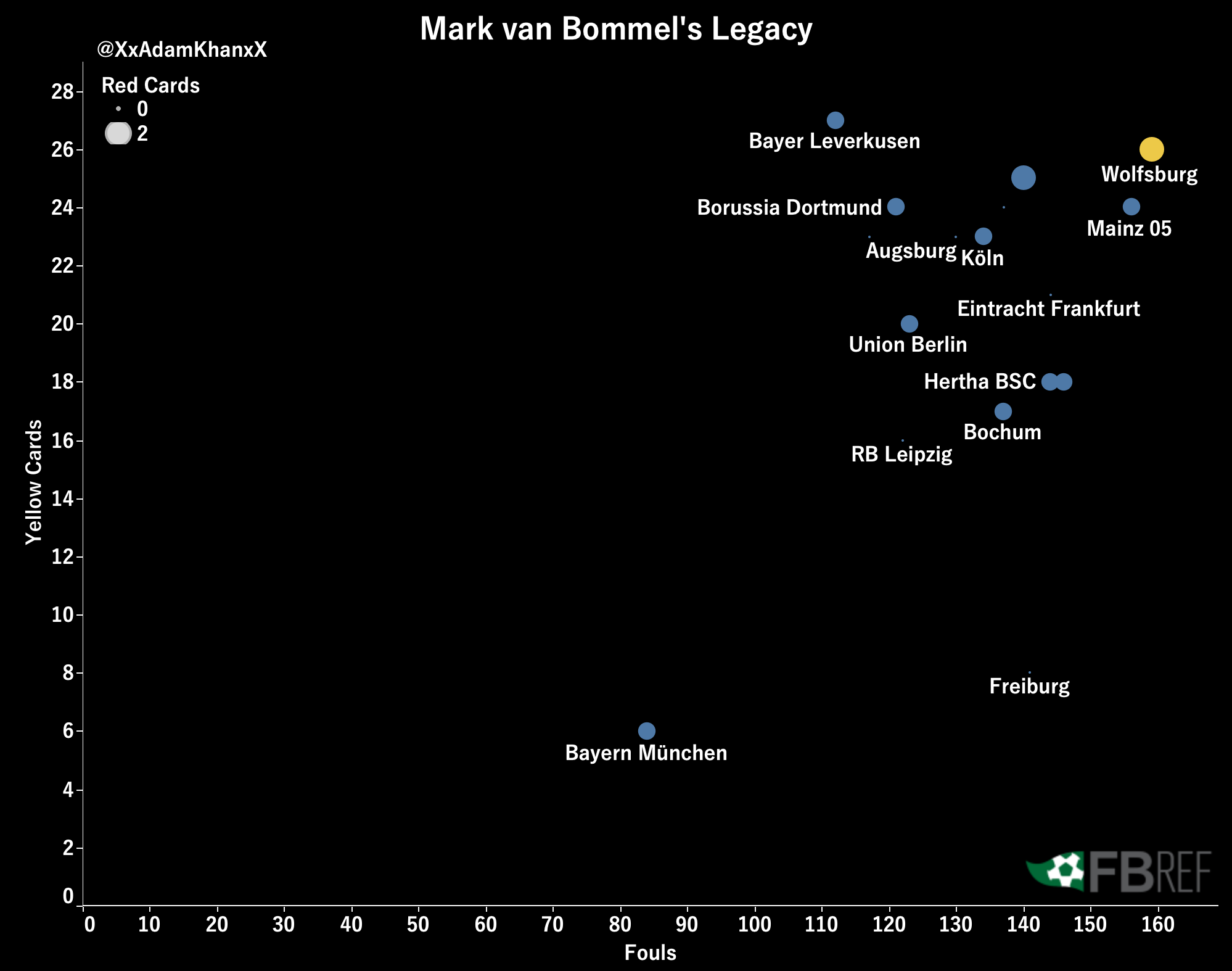The Ultimate Bundesliga 2021/22 Data Analysis
The international breaks are an odd period in the football calendar, offering respite for some, monotonous friendlies for others, and career-defining qualifiers for the rest. Even in the world of sports journalism, the international break can throw a shoe-horn in regular plans, allowing individuals like myself to deviate from the normal schedule, and refine some of my journalistic skills to make the articles and coverage I present even more entertaining.
So, whilst you may have become accustomed to reading my player profiles or tactical analysis on BTL, today I’m switching it up a bit with a Bundesliga data analysis. With a basic knowledge of Tableau (largely thanks to Ninad Barbadikar’s fantastic tutorials), I present to you a very modest data analysis that looks to provide insight into the stylistic themes, tactical strategies and key performers in the 2021-22 Bundesliga!
Feedback and recommendations would be massively appreciated in today’s article, so if you’re a data analysis expert, or just a fan looking for some jovial reading on a Saturday morning, please let me know on twitter which visuals you enjoyed, which you were confused about on, and any, and all ways I could improve.
Enjoy Adam Khan’s Bundesliga content? Then make sure to subscribe to his German Football Newsletter for similar content every Friday!
FC Bayern Munich
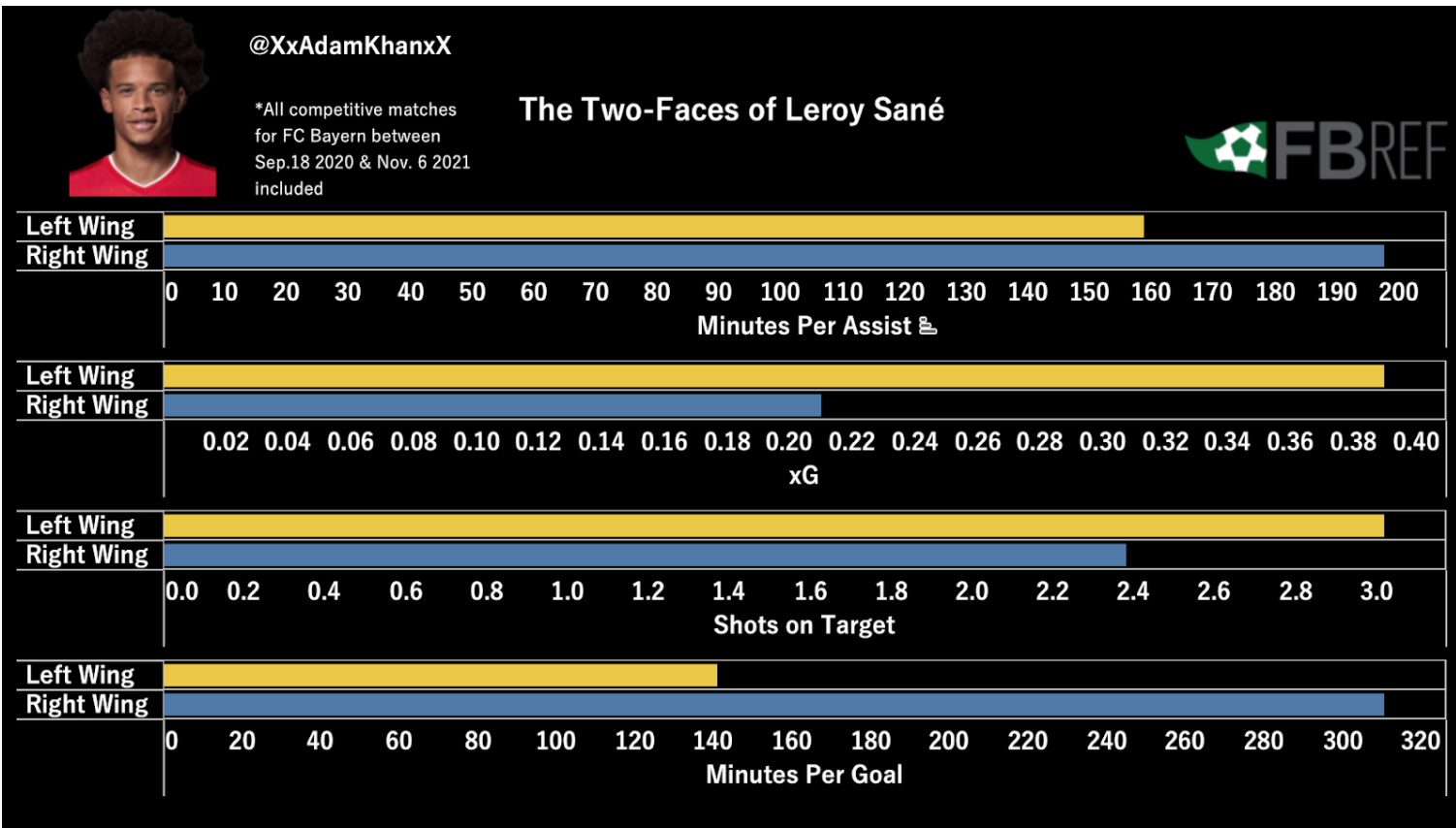
Just months into Julian Nagelsmann’s tenure we are already seeing Bayern expand on the blueprint Hansi Flick laid down. Alphonso Davies is operating higher up the pitch, the Bavarians are routinely building up with a back three, and more than anything Leroy Sané looks reinvigorated.
The 25-year old has the second-most assists of any players in Europe’s top five leagues, and is just 2 goals & 2 assists away from equalling his total output last campaign. One could dedicate an entire piece to what has flipped in Sané’s game, but the most obvious change has been swapping him from the right wing to his preferred left side.
Borussia Dortmund
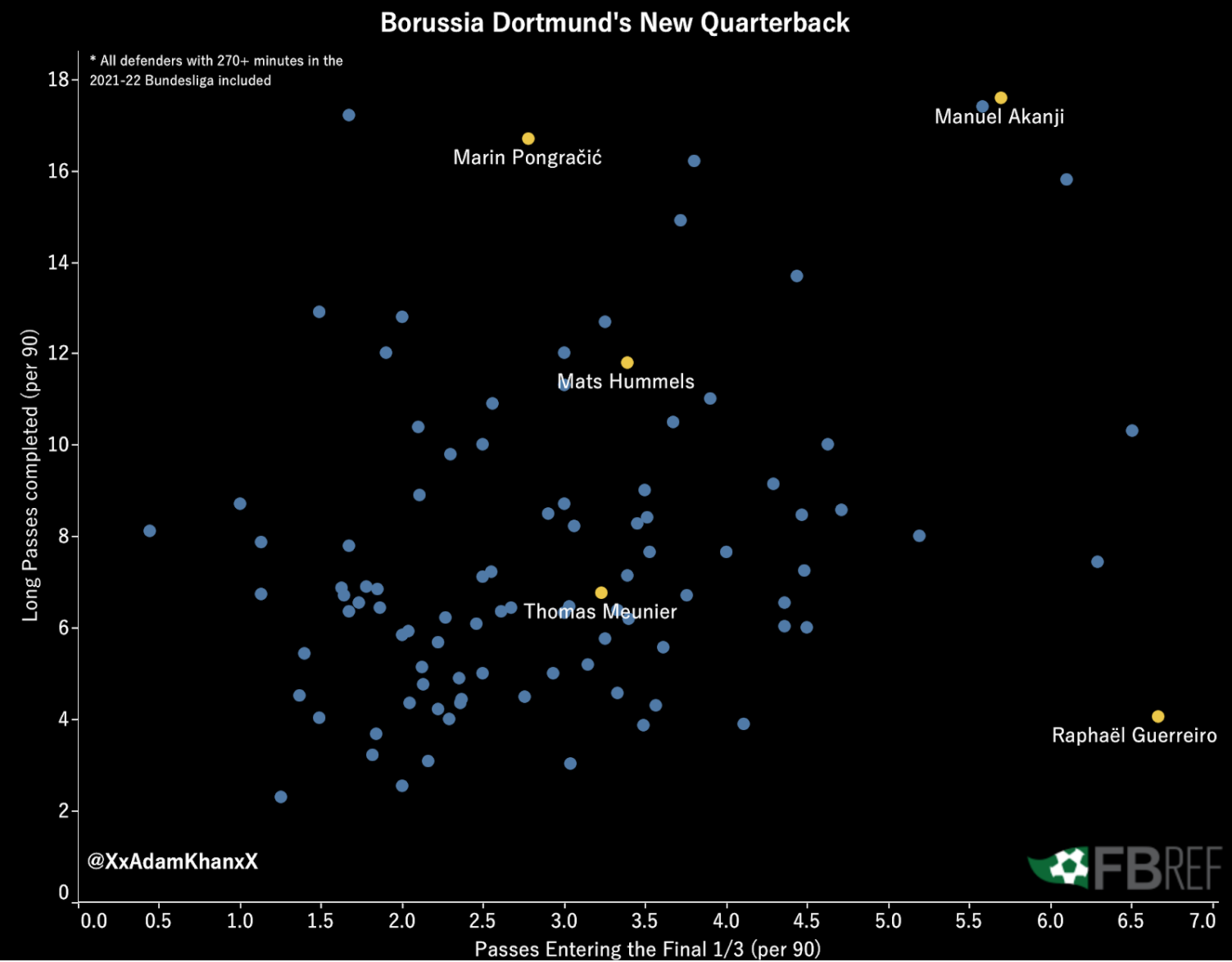
In Mats Hummels, Borussia Dortmund have had one of the greatest ball-playing center backs of the last decade, yet at 32-years of age injuries and the pace of modern forwards are beginning to catch up with the 6 time Bundesliga champion. Therefore, it is another defender in the backline taking up the mantle as BVB’s chief in command.
At 26 years old, Manuel Akanji is playing the most consistent football of his BVB career, leading all Bundesliga center backs in long passes and passes entering the final third. With a contract set to expire this summer, I wouldn’t be surprised to see Akanji lining up in a Premier League defense next season.
SC Freiburg
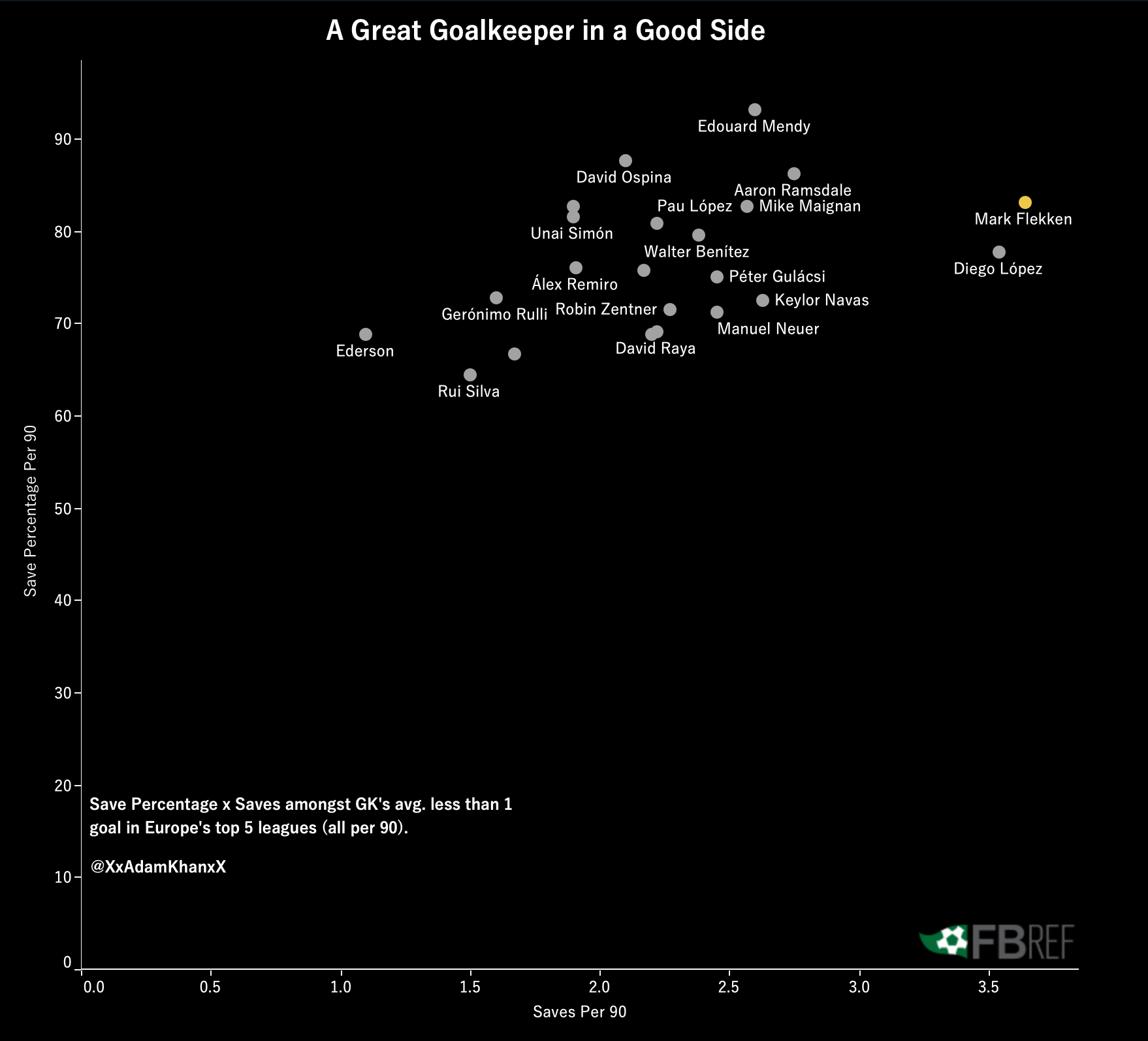
With 9 goals conceded after 11 matchdays, SC Freiburg have the best defense in the Bundesliga and 6th best in any of Europe’s top five leagues. Christian Streich has a disciplined backline, and a collective defensive approach, but more than anything he’s been able to rely on one of the league’s most impressive shot-stoppers.
Amongst goalkeepers playing in strong defensive setups, no one is forced into more saves per 90 than Mark Flekken, whilst only a handful of keepers are making saves at a higher success percentage. Safe to say, Flekken is well-deserving of his second consecutive Dutch national team call-up.
VfL Wolfsburg
In Mark van Bommel the Bundesliga had their first managerial casualty of the season. The Dutchman spent just 115 days in the job, with a stretch of 9 winless matches unraveling the 4-game win streak he began the Bundesliga season with.
Van Bommel professed his deep desire to instill an attack-oriented possession game in Wolfsburg, yet little to none of it was on show at the Volkswagen-Arena. Tepid displays of aimless possession were instead the norm, with key players in the squad failing to buy into the system as results dropped off.
Thus, van Bommel’s biggest legacy is perhaps what he was best known for as a player: getting stuck into a challenge, and picking up yellow cards. Wolfsburg have accumulated the most fouls, second-most yellow cards, and joint-most red cards 11 matches into the campaign.
RB Leipzig
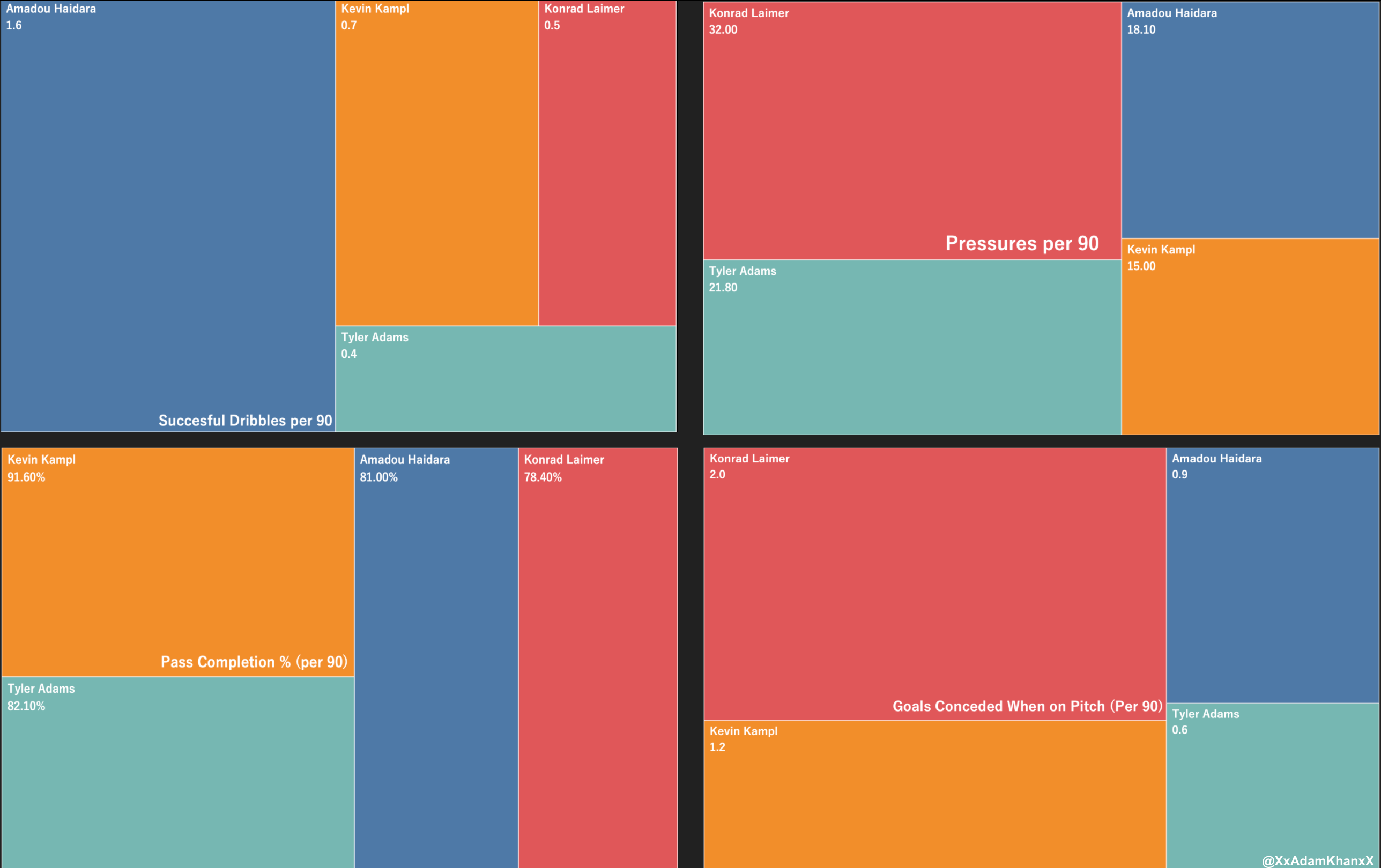
Bayern Munich have by far the strongest XI in this season’s Bundesliga, but when it comes to assessing an entire squad, RB Leipzig aren’t far behind. This is highlighted in central midfield, with Jesse Marsch giving 180+ minutes to 4 different midfielders*.
It’s not just the heavy fixture list that has forced Marsch to constantly shift his midfield, but also the differing skill sets in the personnel available means he can address opposition weaknesses by selecting the right fit for the match at hand.
As the visual above shows, if Marsch is looking to initiate significant pressure then he should make sure to fit Laimer into his squad, whilst in a match in which possession is key, a player like Kevin Kampl can play a crucial role.
* Bayern have given just 3 central midfielders 180+ min.]
Bayer Leverkusen
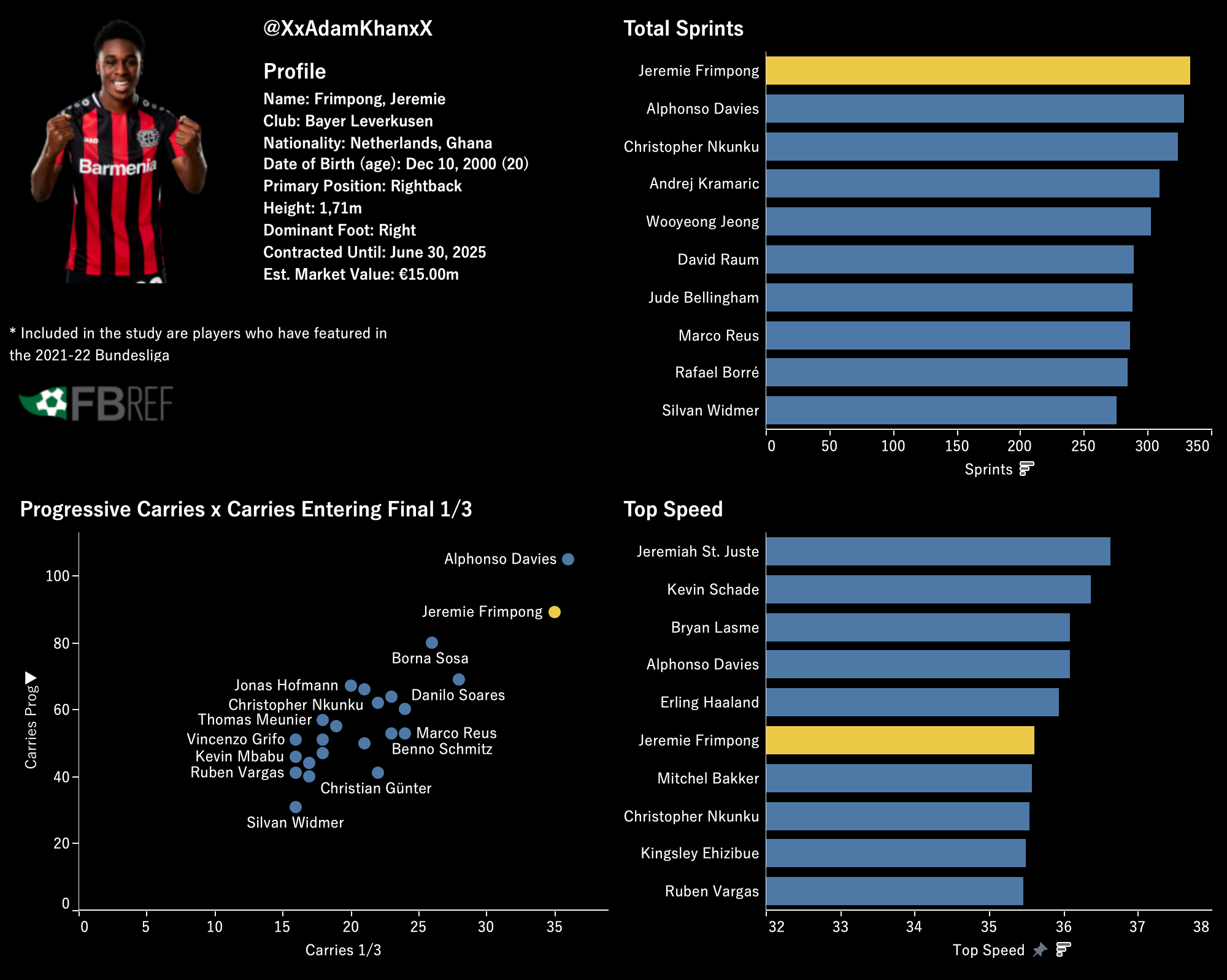
Bayer 04 have dipped in form in recent weeks, failing to win any of their last 4 Bundesliga fixtures. Nevertheless, Die Werkself remain one of the most exciting attacking outfits in Europe with Gerardo Seaone’s side netting the third-most goals in the Bundesliga (24), and second-most in the Europa League (11).
The impressive offensive quintet of Florian Wirtz, Amine Adli, Moussa Diaby, and Patrik Schick have been afforded much of the praise for Leverkusen’s staggering attack, but one figure who has flown under the radar for his contributions is 20-year old Jeremie Frimpong.
Mainz 05
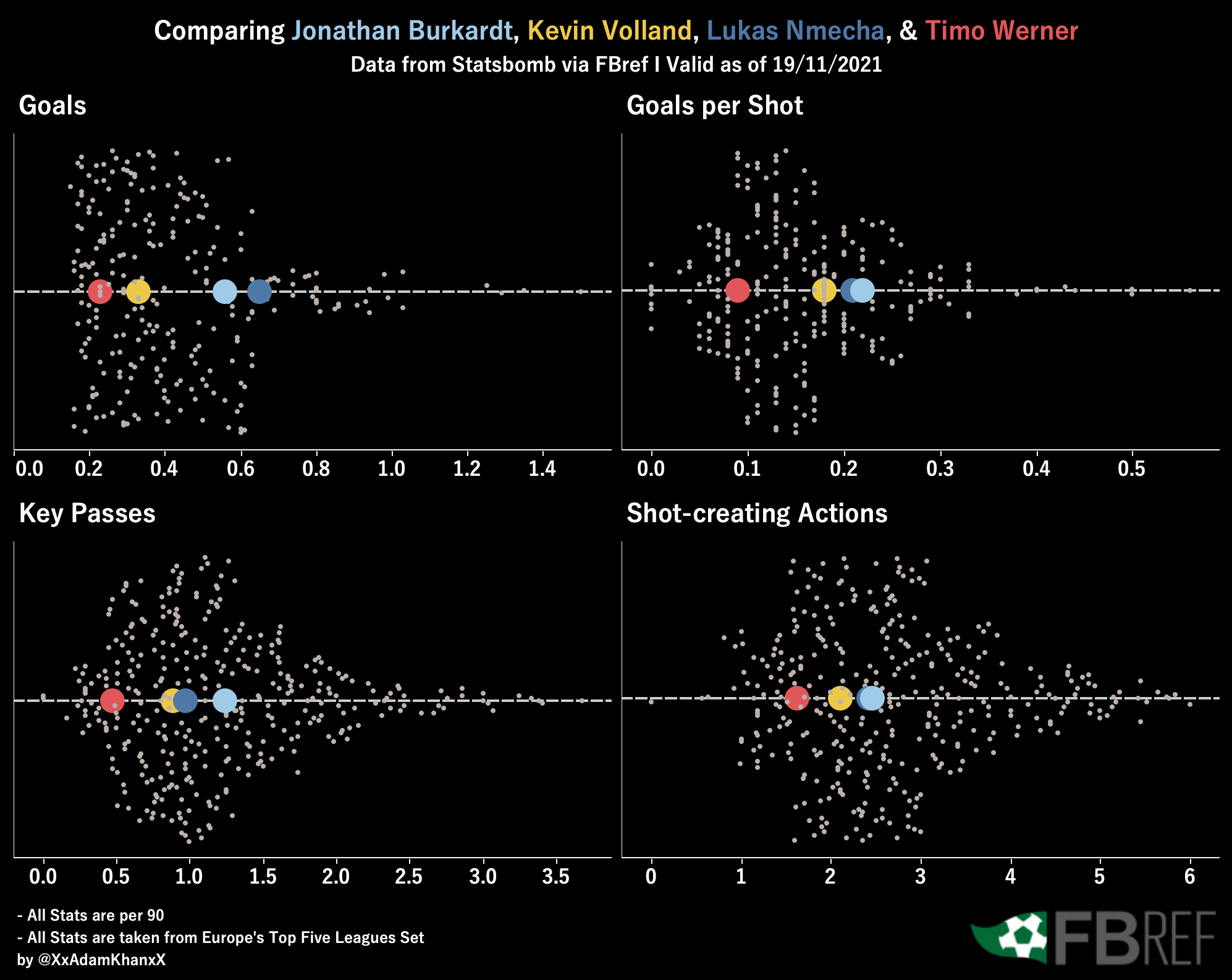
With Germany in search of a traditional number, one name that has been brought up in recent weeks is Mainz 05’s Jonathan Burkardt. The forward is now the captain of Antonio Di Salvio’s under 21 setup, and with 5 goals in 11 Bundesliga matches, Burkardt is making himself noticeable in the Bundesliga and abroad. Here is how he compares to some of Hansi Flick’s alternatives in key creative and goalscoring metrics.
Union Berlin
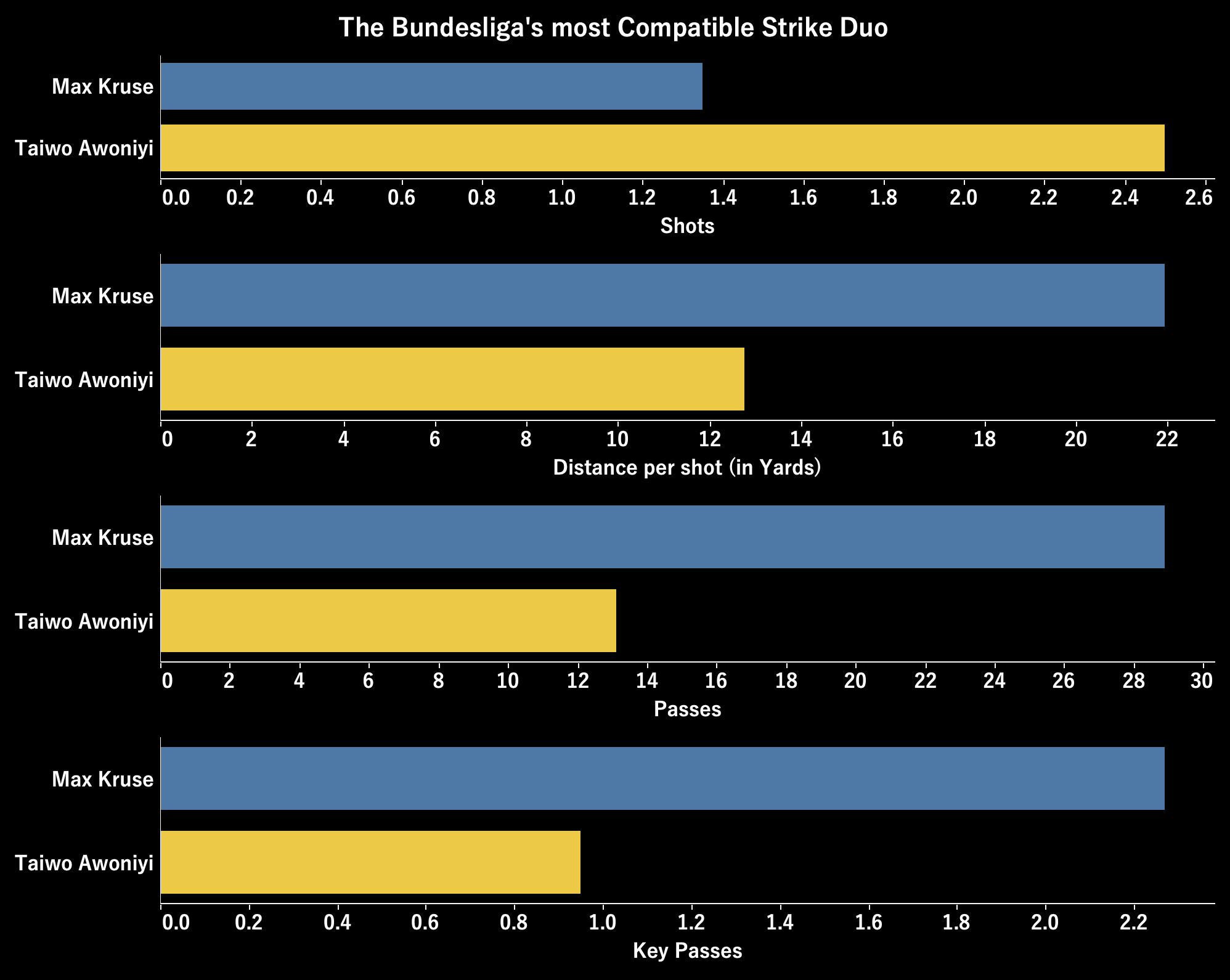
Though the modern era sees more and more sides move away from a two-striker formation, with the duo of Max Kruse and Taiwo Awoniyi, Urs Fischer has brought a traditional 3-4-1-2 back into fashion. What makes Awonuse so potent is how well the two forwards complement each other’s game.
As the viz shows, Kruse is the far more creative and involved forward, whilst Awoniyi is a more potent finisher who looks to make the majority of his offensive actions within 18-yards of the opponent’s goal.
Borussia Mönchengladbach
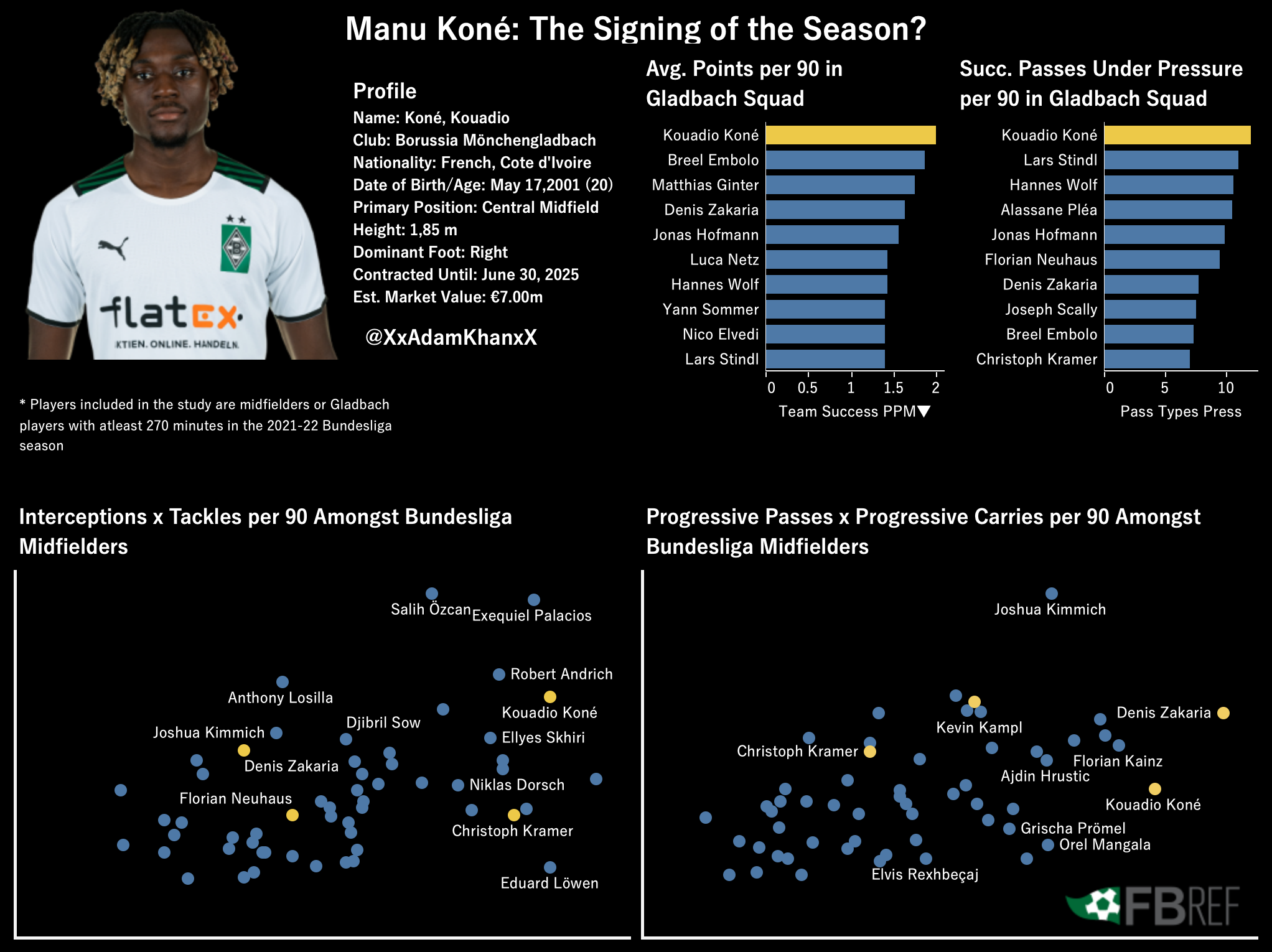
Though a tremendous pokal victory over Bayern at the end of October was cause for widespread optimism, just 4 wins in the opening Bundesliga fixtures sees Die Fohlen Elf tumble about in 9th place after 11 matchdays.
A plight of injuries, an inability to unlock defensive opponents, and a lack of clinical edge have all contributed to this disastrous start, but one figure who has pulled his weight is Manu Koné. The 20-year old was signed from (and loaned back to) Toulouse last January, and is quickly materializing into one of the signings of the season in the Gladbach midfield.
TSG Hoffenheim
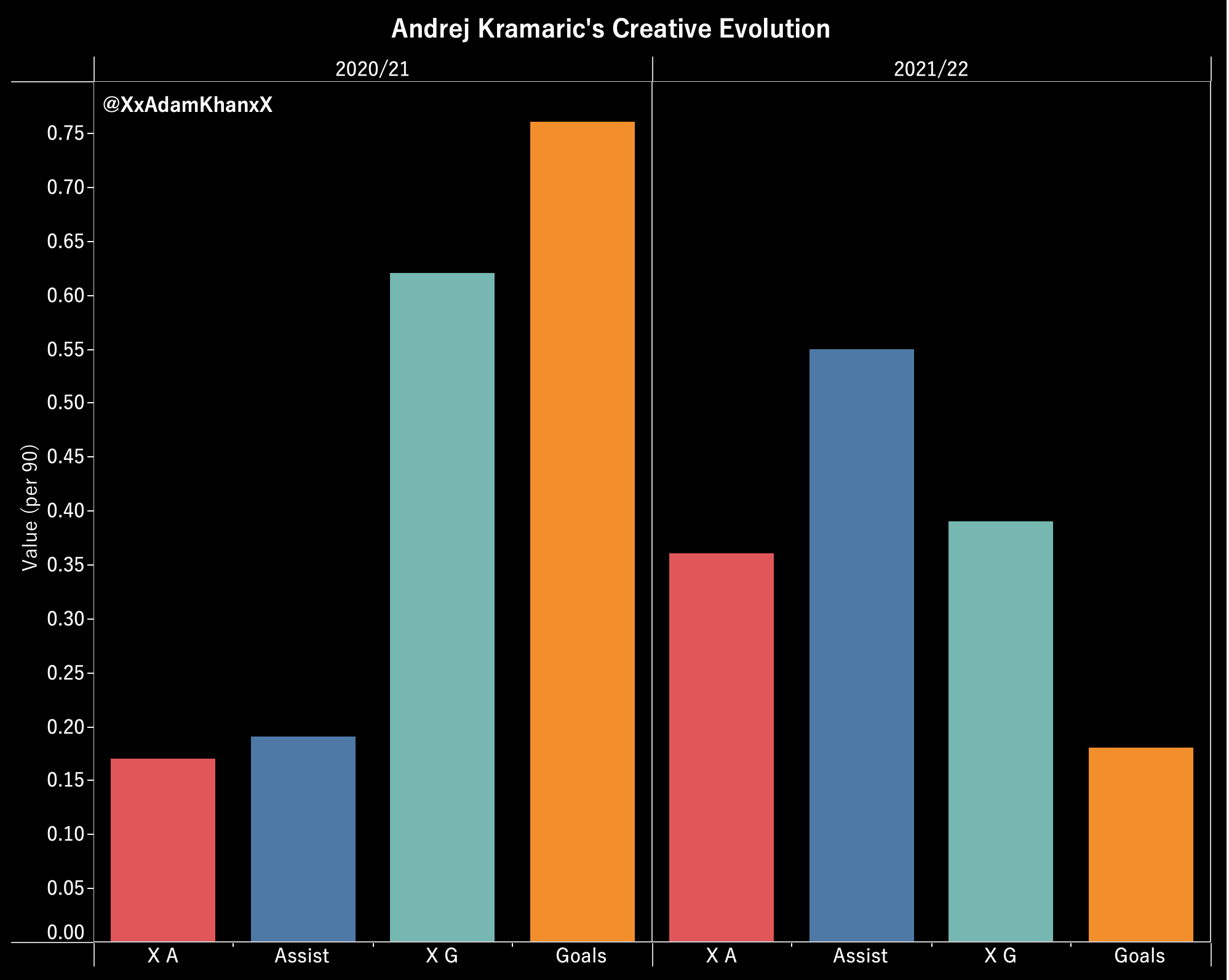
Kramaric has been the key man in Hoffenheim since signing in 2015. In 197 Bundesliga matches he has scored 99 goals for Die Kraichgauer, putting him 32 goals clear as the record-scorer in Hoffenheim’s youthful Bundesliga history. This season, however, we are seeing a new side to the Croatian.
In 6 seasons at the club Kramaric never registered more than 8 assists in the Bundesliga, yet just 11 matches into the current campaign the 30-year old is already on 6. This sees him sit joint-second with the likes of Marco Reus, and Florian Wirtz for the most assists in this season’s Bundesliga – not too bad for a player previously associated with finding the back of the net himself!
1.FC Köln
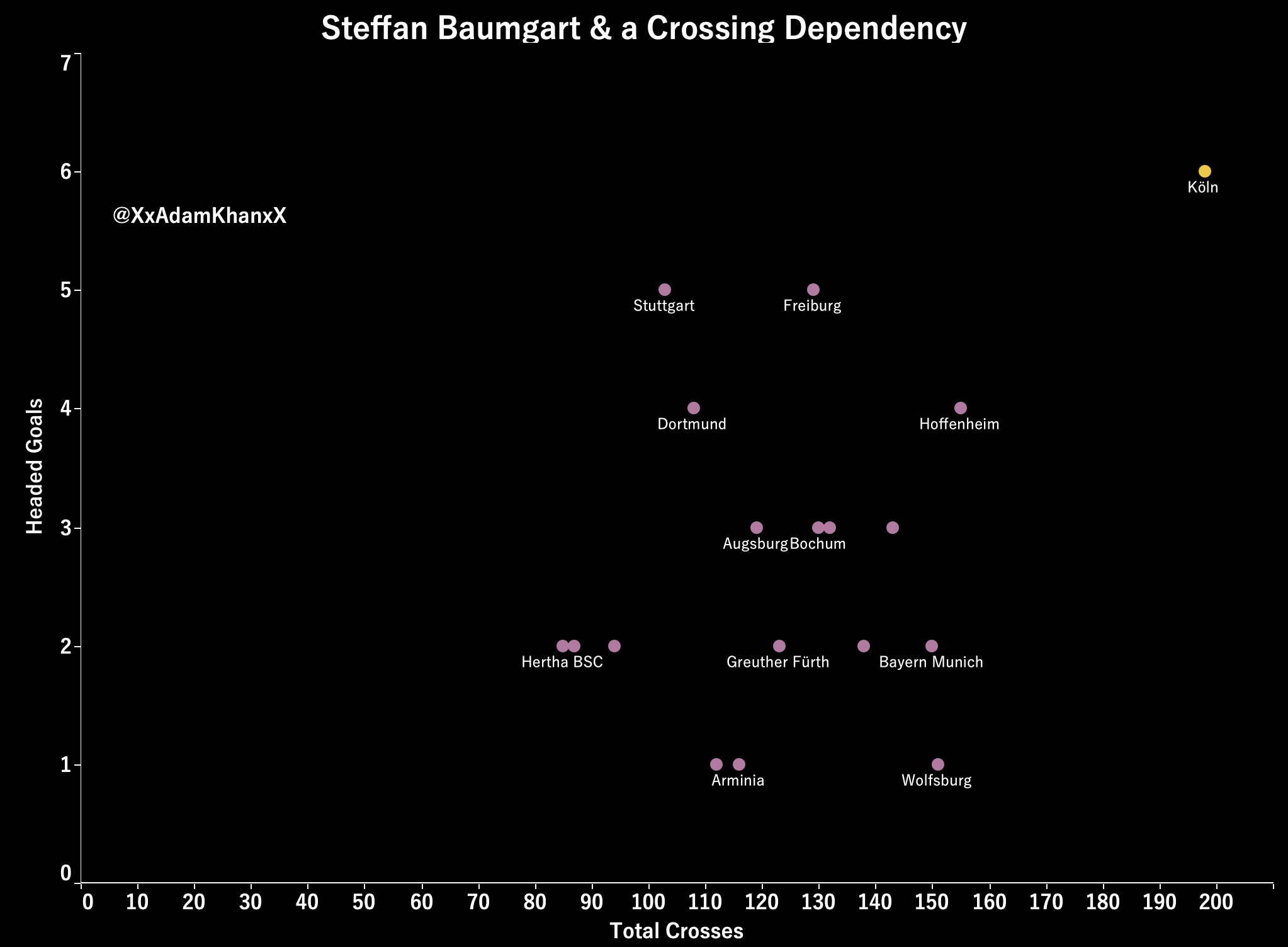
Under Steffan Baumgart, Köln are a far more entertaining package than what we became accustomed to last season. One of the key players Baumgart has revitalized is 33-year old Anthony Modeste.
Baumgart has not just brought the Frenchman back into his plans, but structured his side around his strengths. This Köln side are miles ahead of any competitors for the most crosses this season, whilst 5 of Modeste’s 8 goals have come from a header (the most of any player). It isn’t flowing, intricate, football, but it’s a clear gameplan that should see Köln finish comfortably midtable.
VfL Bochum
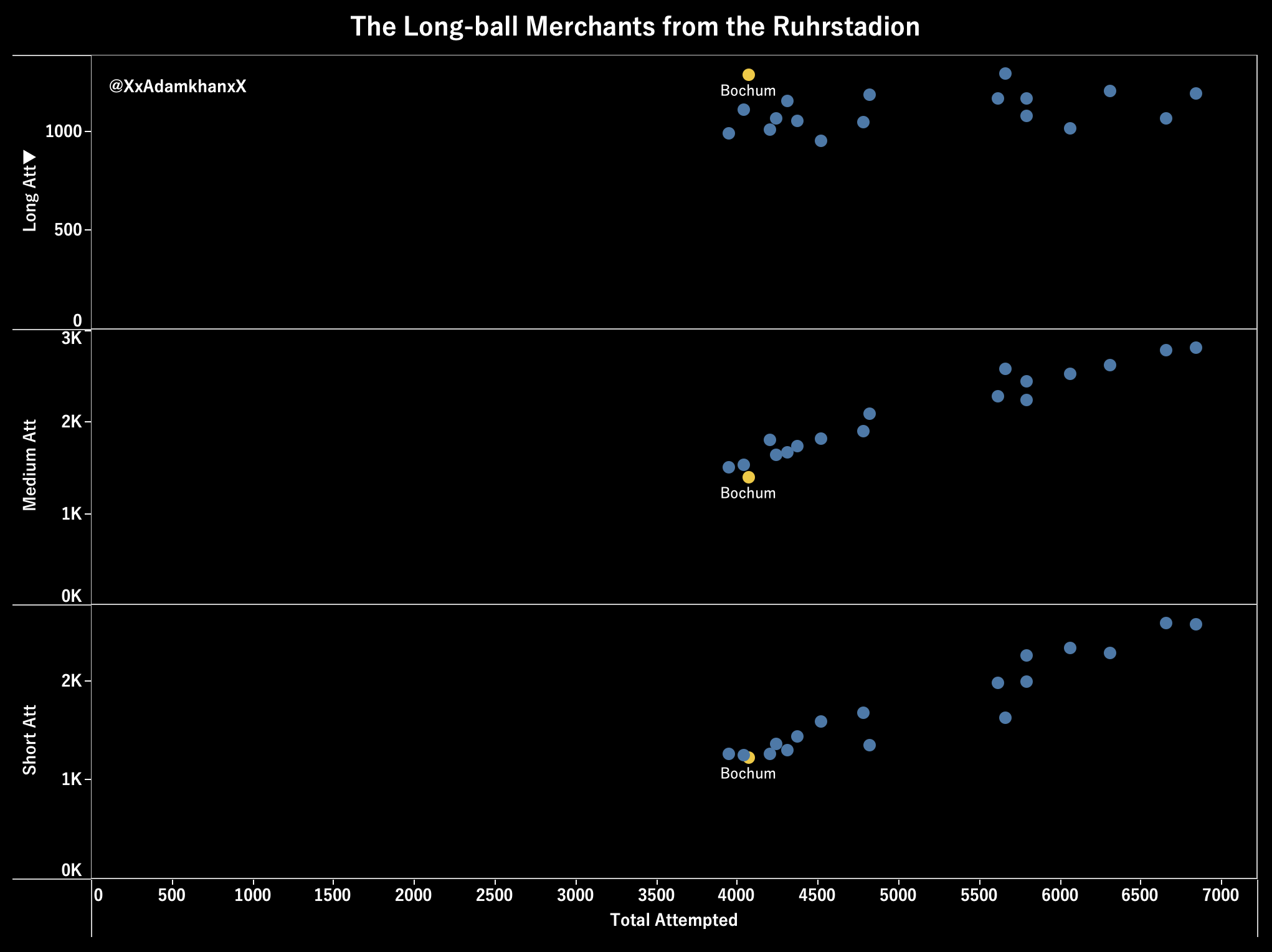
After a sluggish start in which Bochum took just one win from their opening 7 fixtures, the Zweite Bundesliga champions have now slowly begun to grow into their first topflight campaign in more than a decade with 3 wins in their last 4 matchdays.
A massive reason for their comfortable mid-table position is the direct style which Thomas Reis has implemented. Bochum have attempted just the third-fewest passes of any side in the Bundesliga, but when it comes to passes longer than 30 yards, only VFL Wolfsburg have attempted more. Almost every third pass Bochum attempts is over 30 yards!
Hertha BSC
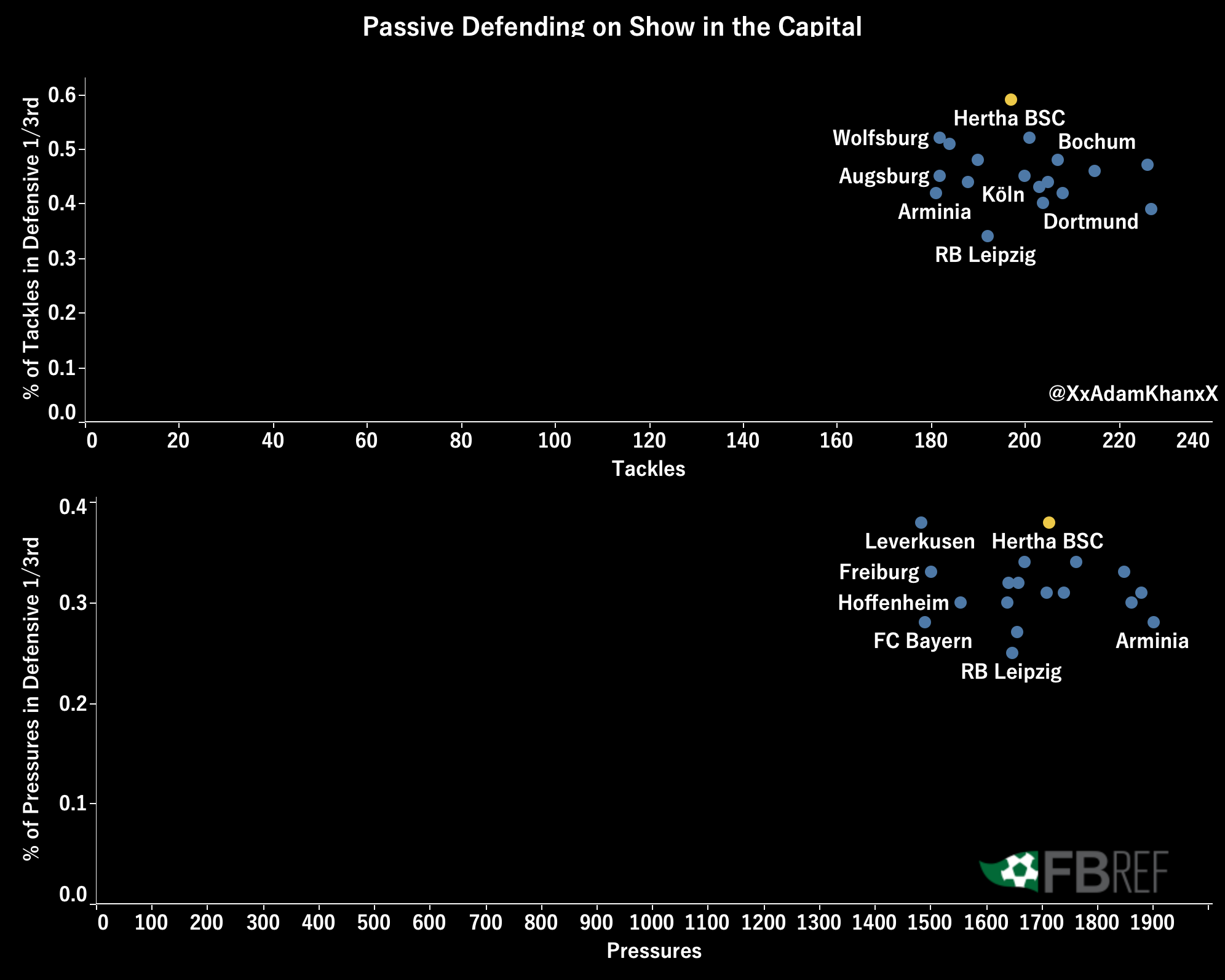
Hertha BSC have stabilized in recent weeks after losing just one of their last 4 Bundesliga fixtures, but the football under Pál Dárdai is anything but attractive. A hard-nosed midfielder in his playing days, Dárdai remains fixed to his defensive identity since assuming a position in the managerial dugout.
As the visual shows, Hertha are extremely passive, barely initiating any pressure in the middle and attacking thirds. It is only in their own defensive third where Dárdai’s side begin to take action, making the vast majority of their tackles and pressures in areas directly in front of their goal.
This same theme is backed up when we look at crosses conceded. Although we weren’t able to incorporate it into the graphic, Hertha BSC conceded by far the most crosses of any Bundesliga club (17 more than second-most Bochum). What this again shows is a side that looks to pack the area in front of their goal, forcing the opponents wide and then hope to win the high percentage aerial duels in their own box.
All in all, it should be enough to stay up, but Pál Dárdai and his ancient tactics are far from what Hertha need to make use of Lars Windhorst’s €375 million investment.
Eintracht Frankfurt
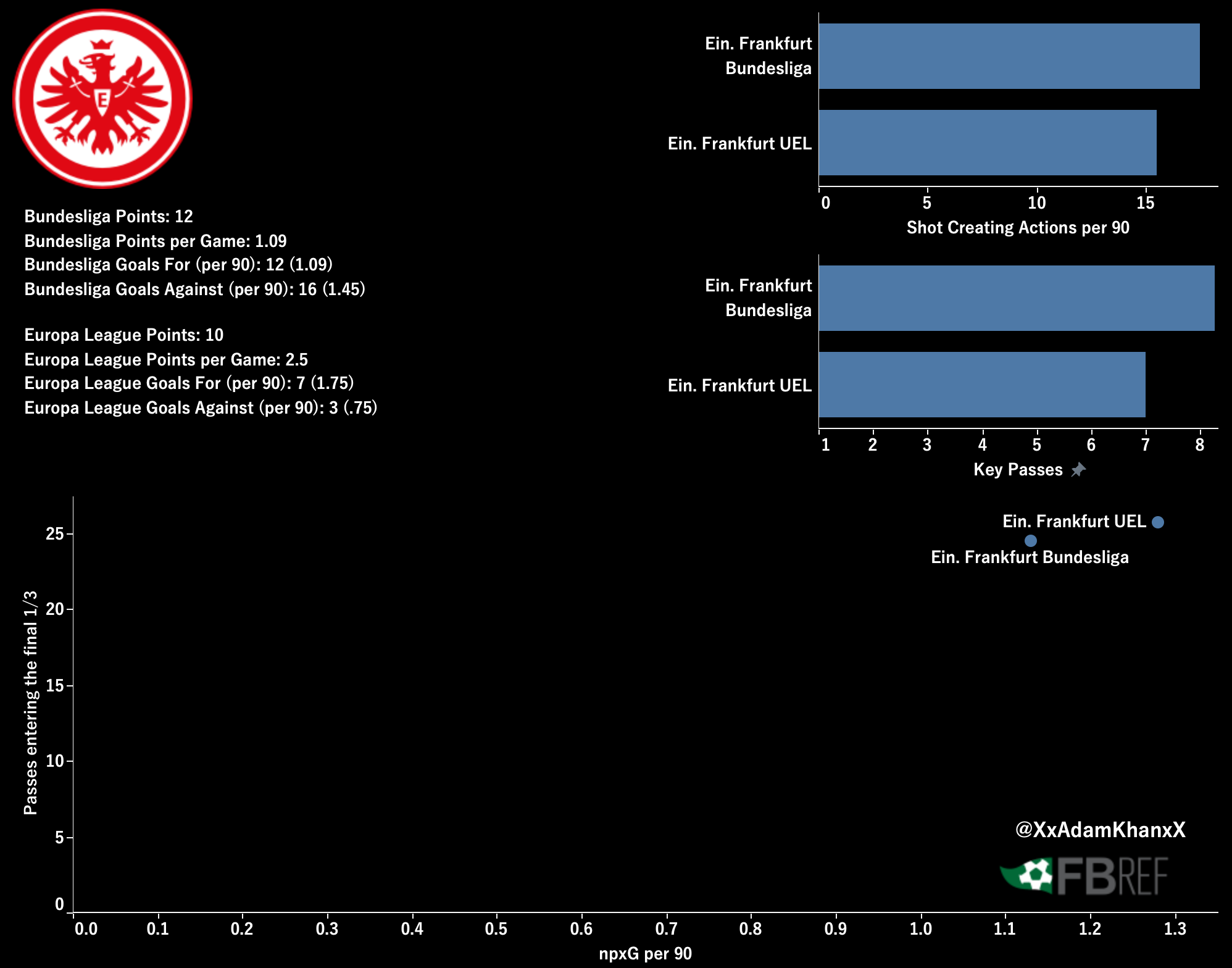
It’s been like watching two different sides this season when comparing Frankfurt’s form in the Europa League vs the Bundesliga. After 4 matches in the UEL, Die Adler have already booked their knockout ticket, taking 6 points off Greek champions Olympiacos Piraeus, and conceding just 3 goals in 360+ minutes.
Domestically things have not been so rosey. Oliver Glasner was knocked out of the Pokal first round by 3rd tier Mannheim, and Frankfurt sit just 2 places above the relegation zone after winning 2 of their opening 11 matches.
Results could not be more different, but surprisingly, the underlying numbers don’t necessarily support this verdict. Frankfurt are taking more shots and entering the final third more often internationally, however the creative numbers are far better in the Bundesliga – a competition in which they are averaging almost 1 fewer goal per game!
It’s ultimately a very small sample size, but it seems like despite the superior results in the Europa League, many of the issues which have caused their domestic form to spiral downwards are just as evident internationally.
VfB Stuttgart
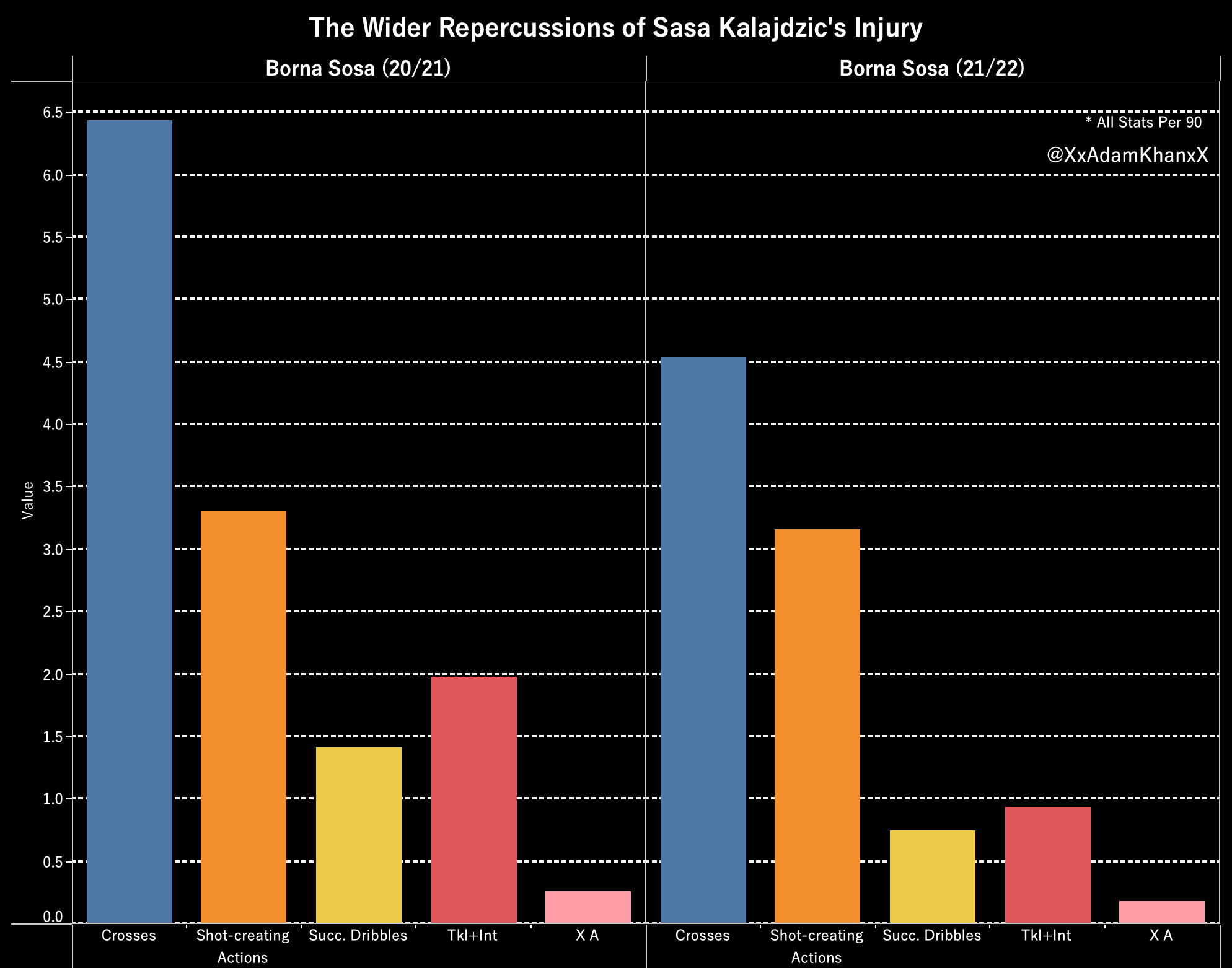
VfB Stuttgart have been riddled with injuries this season, with a total of 13 first team players missing last weekend’s defeat to Arminia Bielefeld. One of those was 24-year old Austrian international Sasa Kalajdzic. The 2,00m forward is once again the tallest player in this season’s Bundesliga, and was a constant threat for Die Schwaben last season, netting 16 goals in 33 matches.
Since the second matchday he has been ruled out with a shoulder injury, an absence which has been sorely missed by fullback Borna Sosa. The Croatian international delivered the second most crosses of any Bundesliga player last season, with the combination of Sasa to Kalajdzic resulting in 5 goals.
This season, Sosa has failed to register a single assist since matchday 1, failing to link up with Stuttgart’s array of attacking options in the same way he did with Big Sasa.
FC Augsburg
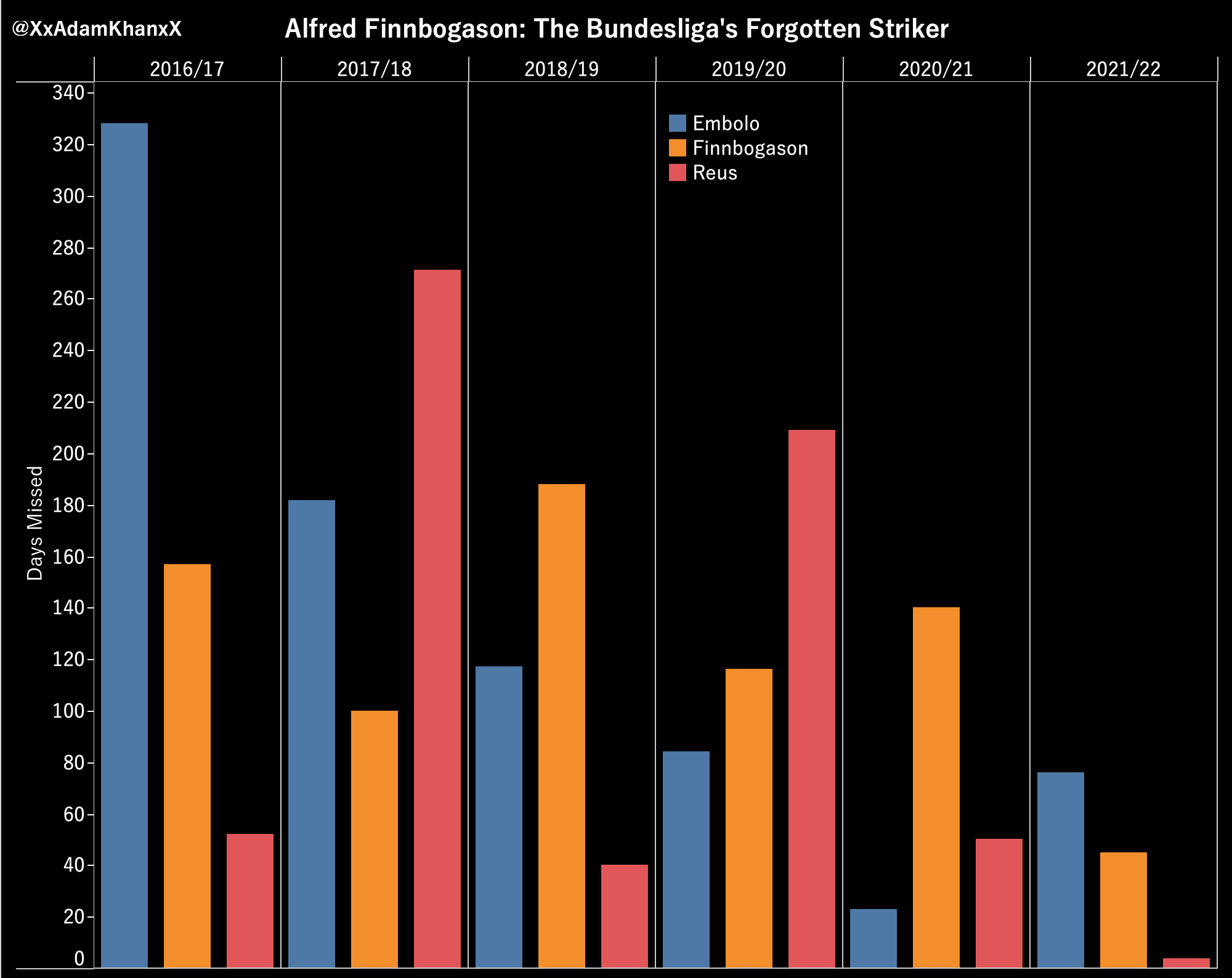
Unless you’re an FC Augsburg supporter or one of the 366,000 inhabiting the Nordic country of Iceland, it would be understandable if the name Alfred Finnbogason has slipped out of your consciousness. Across the past 6 Bundesliga seasons, Finnbogason has missed 749 days with various injuries, more than both Breel Embolo and Marco Reus!
When the 32-year old is on the pitch he remains Augsburg’s most lethal attacker, and with the Függerstadter scoring just 9 goals across the opening 11 matchdays, keeping Finnbogason fit could end up being the key to ensuring topflight survival for the 11th season in a row.
Arminia Bielefeld
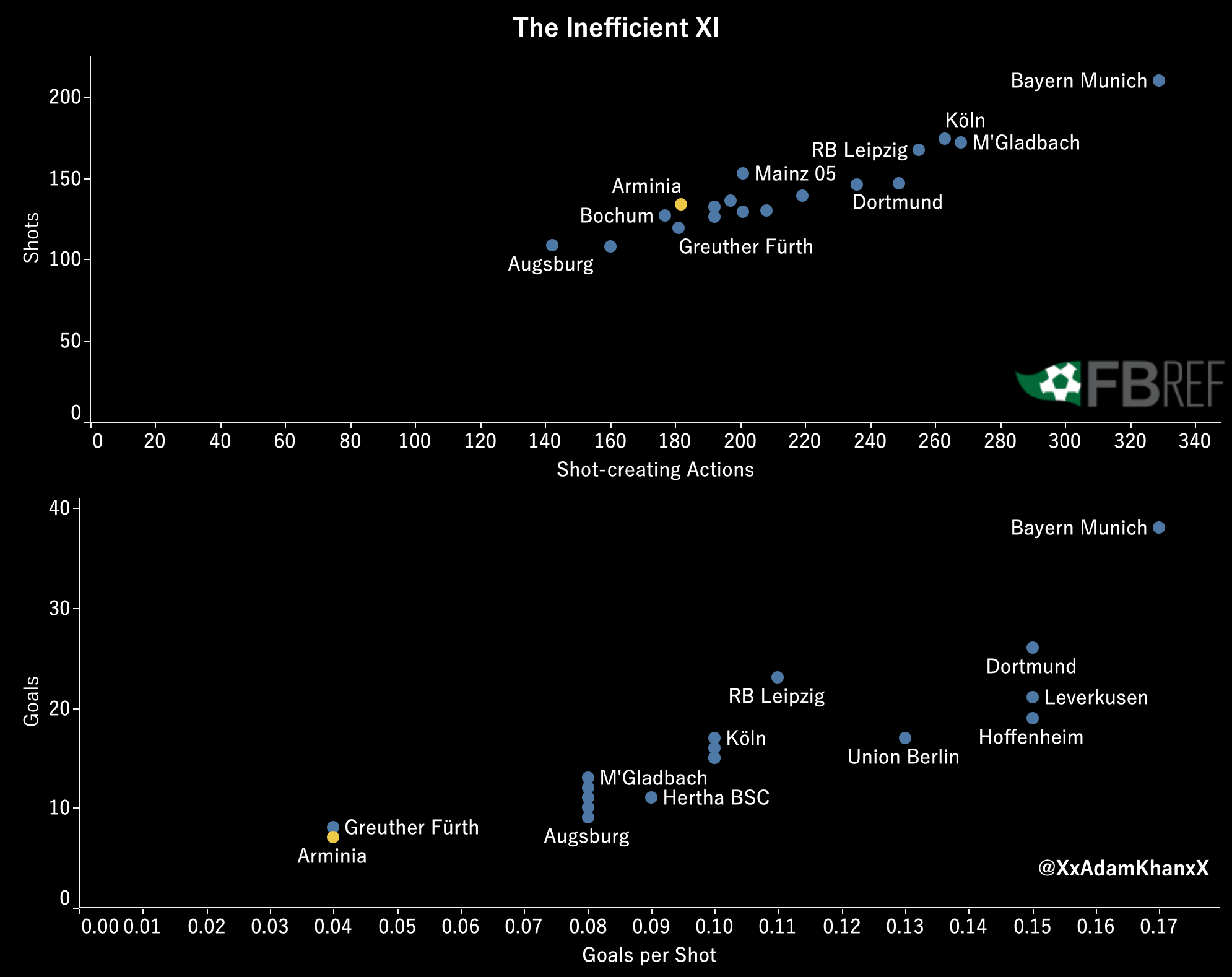
After narrowly staying up last season, Arminia Bielefeld are once again finding it challenging to retain their topflight status this year. A solid defense around Stefan Ortega and Amos Pieper means they have the 9th best defense in the division, however a measly 7 goals after 11 matchdays is far from good enough.
If Bielefeld wants to address this issue they should look for a clinical goalscorer in the January window. The creative numbers are fairly average, and it’s simply down to final third efficiency that they are nestled deep in a relegation battle.
Greuther Fürth
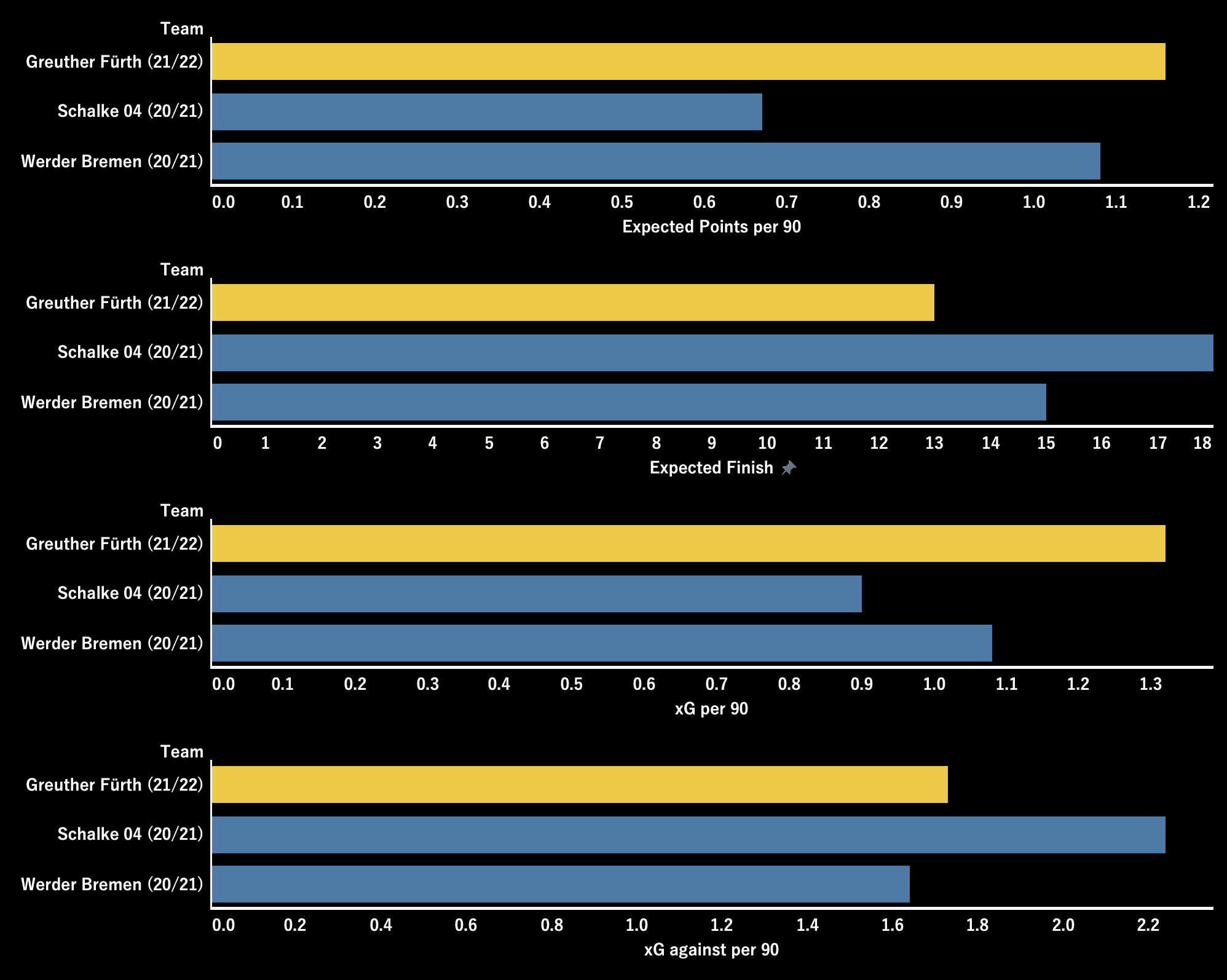
Greuther Fürth have been dismal since promotion last season. Stefan Leitl’s side have taken just one point out of their first 11 encounters, have conceded a league-high 29 goals, and have scored the second fewest of any team in the Bundesliga. In just their second ever Bundesliga campaign, Die Kleeblätter are on course to smash multiple records for the worst ever defense and points tally.
Yet, somehow Fürth have also shown glimpses of their talent, particularly highlighted in their underlying numbers. The Bundesliga bottom-dwellers are outperforming both Schalke 04 & Werder Bremen in key statistics like expected finish, expected goals per 90, and expected points per 90, whilst Bremen are only marginally better in xG against per 90.
Though underlying numbers count for little when you are 9 points adrift, it should at least shed a bit of light into the misfortune which has underlined many of Fürth’s performances.
By: Adam Khan / @XxAdamKhanxX
Featured Image: @GabFoligno / DeFodi Images / Soccrates Images / Sebastian Widmann – Getty Images
Did you enjoy this data analysis? Then make sure to subscribe to Adam Khan’s Bundesliga Newsletter for similar content every week!
